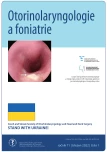The effect of surgical therapy of obstructive sleep apnoea syndrome on Positive Airway Pressure therapy – first results
Authors:
J. Kalhous 1 3
; Kordík J. 2
Authors‘ workplace:
Klinika ORL a chirurgie hlavy a krku UJEP, Krajská zdravotní, a. s. – Masarykova nemocnice v Ústí nad Labem, o. z.
1; Centrum pro poruchy dýchání ve spánku, Krajská zdravotní, a. s. – Masarykova nemocnice v Ústí nad Labem, o. z.
2; LF v Hradci Králové, UK, Praha
3
Published in:
Otorinolaryngol Foniatr, 71, 2022, No. 1, pp. 13-17.
Category:
Original Article
doi:
https://doi.org/10.48095/ccorl202213
Overview
Introduction: Positive Airway Pressure (PAP, CPAP / BPAP) is the method of choice in patients with sleep apnoea syndrome is, surgical intervention is usually a last resort. Some patients with PAP who are treated suboptimally may also benefit from concomitant surgery. Material and methods: The study included 14 patients with severe obstructive sleep apnoea syndrome (age 17–65, baseline AHI 31–120) who were indicated for PAP therapy and whose treatment was suboptimal for various reasons. All patients underwent oropharyngeal surgery (tonsillectomy, uvulopalatopharyngoplasty, radiofrequency-assisted uvuloplasty, or a combination thereof). Two months after the surgery, a controlled limited polygraphy and off-line re-titration of the ventilation device were performed. Monitored parameters: 1. subjective difficulties preventing further use of PAP treatment, 2. AHI before and after surgery, 3. the level of pressure on the PAP device before and after surgery. Results: None of the patients in our group had problems preventing further use of the ventilation device. In all patients there was a statistically significant reduction in AHI after surgery (p = 0.000983). The mean reduction in AHI was 49 (±28). Five patients did not continue treatment with CPAP / BPAP because they reached the limit of the indicative criteria for PAP (AHI 15), so their treatment can be considered successful. In seven of the remaining nine patients, it was possible to reduce the pressure on the device after re-titration, in two it remained at the original level. The mean pressure drop on the PAP device after re-titration was 5 mBar (±3.2), the average reduction was 31% (±20%). The difference between the values before and after surgery is statistically significant (p = 0.01796). Conclusion: The results of our pilot study show that patients with OSAS who are treated with non-invasive ventilation and whose treatment is suboptimal can benefit from concomitant surgical therapy. None of the patients in our cohort had problems with postoperative use of PAP therapy, while all had a decrease in AHI and most had a decrease in pressure on the PAP device.
Keywords:
uvulopalatopharyngoplasty – tonsillectomy – drug induced sleep endoscopy – positive airway pressure – DISE
Sources
1. Garvey JF, Pengo MF, Drakatos P et al. Epidemiological aspects of obstructive sleep apnea. J Thorac Dis 2015; 7 (5): 920–929. Doi: 10.3978/j.issn.2072-1439.2015.04.52.
2. Betka J, Klozar J, Kuchař M et al. Obstrukční syndrom spánkové apnoe – srovnání efektivity různých chirurgických přístupů. Otorinolaryngol Foniatr 2014; 63 (1): 3–9.
3. Friedman M, Salapatas AM, Bonzelaar LB. Updated Friedman Staging System for Obstructive Sleep Apnea. Adv Otorhinolaryngol 2017; 80: 41–48. Doi: 10.1159/000470859.
4. Kezirian EJ, Hohenhorst W, de Vries N. Drug-induced sleep endoscopy: the VOTE classification. Eur Arch Otorhinolaryngol 2011; 268 (8): 1233–1236. Doi: 10.1007/s00405-011-1633-8.
5. Vicini C, De Vito A, Benazzo M et al. The nose oropharynx hypopharynx and larynx (NOHL) classification: a new system of diagnostic standardized examination for OSAHS patients. Eur Arch Otorhinolaryngol 2012; 269 (4): 1297–1300. Doi: 10.1007/s00405-012-1965-z.
6. Friedman M, Soans R, Joseph N et al. The effect of multilevel upper airway surgery on continuous positive airway pressure therapy in obstructive sleep apnea/hypopnea syndrome. Laryngoscope 2009; 119 (1): 193–196. Doi: 10.1002/lary.20021.
7. Chandrashekariah R, Shaman Z, Auckley D. Impact of upper airway surgery on CPAP compliance in difficult-to-manage obstructive sleep apnea. Arch Otolaryngol Head Neck Surg 2008; 134 (9): 926–930. Doi: 10.1001/archotol.134.9. 926.
8. Khan A, Ramar K, Maddirala S et al. Uvulopalatopharyngoplasty in the management of obstructive sleep apnea: the mayo clinic experience. Mayo Clin Proc 2009; 84 (9): 795–800. Doi: 10.1016/S0025-6196 (11) 60489-8.
9. Zonato AI, Bittencourt LR, Martinho FL et al. Upper airway surgery: the effect on nasal continuous positive airway pressure titration on obstructive sleep apnea patients. Eur Arch Otorhinolaryngol 2006; 263 (5): 481–486. Doi: 10.1007/s00405-005-1018-y.
Labels
Audiology Paediatric ENT ENT (Otorhinolaryngology)Article was published in
Otorhinolaryngology and Phoniatrics

2022 Issue 1
Most read in this issue
- Isolated lesion of the hypoglossal nerve as the result of an internal carotid artery aneurysm – case report
- Adaptation and validation of the Czech version of the nasal obstruction symptom evaluation scale (NOSE-cz)
- Microenvironment of squamous cell carcinoma of the head and neck as an analogy of a healing wound
- Coexistent parapharyngeal epithelial-myoepithelial carcinoma and bilateral Warthin’s tumors
